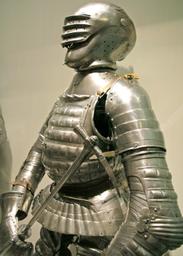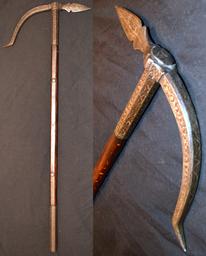A war hammer is a late medieval weapon of war intended for close combat action, whose design resembles the hammer. Its appearance is similar to that of an ice axe. Originating in Europe and the Middle East, it was later introduced to Mughal India.
Design
A war hammer consists of a handle and a head. The length of the handle may vary, the longest being roughly equivalent to that of a halberd, and the shortest about the same as that of a mace. Long war hammers were pole weapons, or polearms, meant for use against riders, whereas short ones were used in closer quarters and from horseback.
War hammers were developed as a consequence of the prevalence of surface-hardened steel surfacing of wrought iron armors of the late medieval battlefields during the fourteenth and fifteenth centuries. The surface of armors had become as hard as the edge of a blade, so blades tended to ricochet. Swords and battleaxes were likely to give only glancing blows, losing much of their impact, especially on the high curvature of helmets. A war hammer could deliver the full force of a blow to the target.
War hammers, especially when mounted on a pole, could damage without penetrating armor. In particular, they transmitted their impact through even the thickest helmets and caused concussions. Later war hammers often had a spike on one side of the head, making them more versatile weapons. A blade or spike tended to be used not against helmets but against other parts of the body where the armor was thinner and penetration was easier. The spike end could be used for grappling the target's armor, reins, or shield, or could be turned in the direction of the blow to pierce even heavy armor. Against mounted opponents, the weapon could also be directed at the legs of a horse, toppling the armored foe to the ground where they could be more easily attacked.
Maul
A maul is a long-handled hammer with a heavy metal head, either of lead or iron. Similar in appearance and function to a modern sledgehammer, it is sometimes shown as having a spear-like spike on the fore-end of the haft.
The use of the maul as a weapon seems to date from the later 14th century. In 1382, rebellious citizens of Paris seized 3,000 mauls (French: maillet) from the city armory, leading to the rebels being dubbed Maillotins. Later in the same year, Froissart records French men-at-arms using mauls at the Battle of Roosebeke, demonstrating that they were not simply weapons of the lower classes.
A particular use of the maul was by archers in the 15th and 16th centuries. At the Battle of Agincourt, English longbowmen are recorded as using lead mauls, initially as a tool to drive in stakes but later as improvised weapons. Other references during the century (for example, in Charles the Bold's 1472 Ordinance) suggest continued use. They are recorded as a weapon of Tudor archers as late as 1562.





